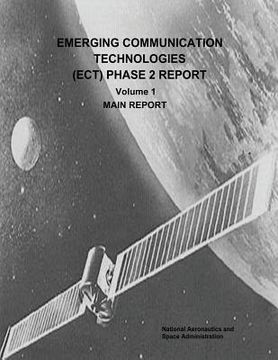Emerging Communication Technologies (ECT) Phase 2 Report: Volume 1 - Main Report (in English)
Synopsis "Emerging Communication Technologies (ECT) Phase 2 Report: Volume 1 - Main Report (in English)"
The National Aeronautics and Space Administration (NASA) is investigating alternative approaches, technologies, and communication network architectures to facilitate building the Spaceports and Ranges of the future. These investigations support the Second Generation Reusable Launch Vehicle (2nd Gen RLV), Orbital Space Plane (OSP) and other associated craft presently under development or under consideration in Government, academic, and private sectors. These investigations also provide a national centralized R&D forum for next-generation Spaceport and Range technology development. Together, these sectors all share the common goal of changing the historic risk/reward equation for access to space, with the intent to: Dramatically reduce launch cost, Greatly improve launch system reliability, Significantly reduce crew risk. The shared and tacit goal is to achieve routine access to space. A fundamental paradigm shift is required to accomplish the desired goal. The historical approach of using dedicated and custom Range information equipment situated at relatively few and widely dispersed Spaceports as the only access to space must change before routine access to space can occur. This change is analogous to the historical transformation that occurred in aviation; moving from dedicated, remote test sites where test pilots first experimented with jet-propelled aircraft to today's thriving international and regional airports. Information networks at Spaceports and Ranges must transition to a total integration of existing, new, and emerging technologies that provide a new and robust way of interconnecting the Range assets, Range operations, and Range users during the launch event. This paradigm shift must occur despite the legacy of how the networks have evolved to this point. Instead of the dedicated, immobile, inflexible information infrastructures of today's Ranges and Spaceports, a more flexible approach is needed. Implicit in this flexibility is the need for modularization, to allow incorporation of newer technologies not yet imagined, without requiring scrapping future systems not yet even defined. The key is to envision a transition to a Space Based Range Distributed Subsystem, while enabling mobile and easy-to-reconfigure communication techniques around the edges of fixed, existing, information infrastructures. To enable this, the Emerging Communication Technology (ECT) research task documented in this report provides a keen vision of so-called First Mile technologies in support of NASA's Advanced Range Technology Working Group (ARTWG) and the Advanced Spaceport Technology Working Group (ASTWG) with the purpose of interconnecting mobile users with existing Range Communication infrastructures. Consistent with the goals originally identified for RISM (Range Information System Management) during the first year of this task, and continuing with the detailed research conducted on ECT during the second year of this ongoing research, this report details the results of researching and documenting the technical needs and technical characteristics of future Ranges, Range systems, and Range users. Specifically, this report explores Wireless Ethernet (Wi-Fi), Free Space Optical (FSO), and Ultra Wideband (UWB) communication technologies.

